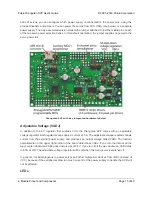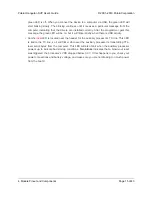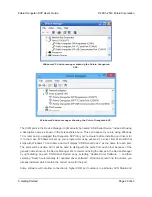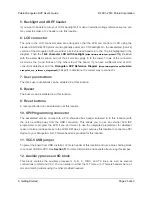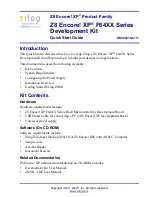
USB Power
When connected to a computer, the USB connection provides a 5 V power supply. If an external power
supply is present, the unit will run off of the external supply and not draw any power from USB. If only
the USB power is present, then by default the auxiliary processor will be powered from USB, but the
AVR and the VCC power pins on the board will not be powered. An option is available for powering
the entire board from USB. See
Section 11
for more information.
Motors
The motor drivers are controlled by two of the AVR’s hardware PWM outputs from eight-bit Timer2 for
speed control, along with two digital outputs for direction control. This lets you achieve variable motor
speeds using hardware PWMs rather than processor-intensive software PWMs on the motor control
lines. You can control the motors using the functions in the
OrangutanMotors
[https://www.pololu.com/
docs/0J18/7]
section of the Pololu AVR C/C++ Library.
For each motor, the Orangutan SVP has a current-sensing circuit that produces an output voltage
proportional to the current the motors are using (850 mV/A). The respective outputs of these circuits
are labeled CS1 and CS2, and they are accessible near the center of the board.
User I/O & Power Outputs
Sixteen user I/O lines can be accessed via the four 4×3 0.100" female headers along the lower edger
of the board, as shown below. Each I/O line has associated power and ground connections for easy
connections to sensors: the exterior (bottom) pin is ground, the middle pin is power, and the interior
(top) pin is signal and connects directly to an AVR I/O line.
For each four-pin bank of I/O lines, you can configure which power voltage is supplied to the power
(middle) pins. By default, the power pins are connected to VCC (5 V). You can cut a trace on the
bottom of the board to disconnect them from VCC. This will leave the power pins connected to one
through-hole, which can be connected to a different power source, such as VADJ, which is available
elsewhere on the board.
The total current available on the VCC (5 V) line is 3 A, meaning you can power servos and other
high-power peripherals directly from your regulated voltage.
LCD
The Orangutan SVP is supplied with a removable 16×2 character LCD with backlight that uses the
common
HD44780 parallel interface
[https://www.pololu.com/file/0J71/DMC50448N-AAE-AD.pdf]
(109k pdf).
A different LCD can be connected with an appropriate cable. The AVR has four I/O lines connected
to LCD data lines DB4 – DB7 (i.e. is configured to use the LCD in 4-bit mode) and three I/O lines
connected to the three LCD control lines RS, R/W, and E. Please note that the LCD data lines are also
Pololu Orangutan SVP User’s Guide
© 2001–2019 Pololu Corporation
4. Module Pinout and Components
Page 10 of 43













